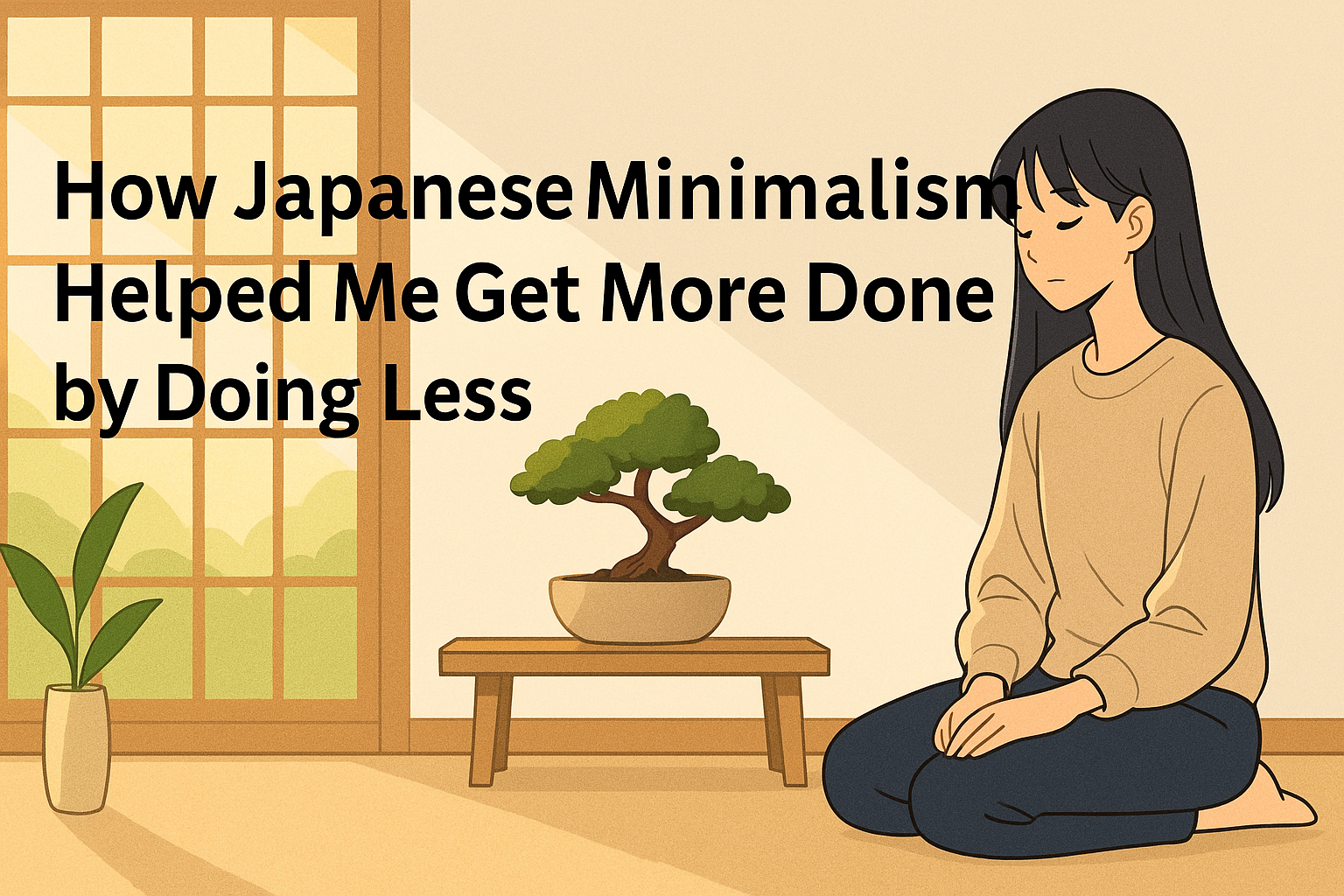The Japanese Art of Doing Less to Get More Done
- Introduction: Why Doing Less Is a Powerful Productivity Tool
- 1. My Initial Struggles with Doing Less and Staying Productive
- 2. Reducing Tasks to Improve Focus and Mental Clarity
- 3. How Japanese Simplicity Inspired My Minimalist Approach to Work
- 4. Creating a Calmer, More Intentional Daily Work Rhythm
- 5. Life Lessons from Japanese Minimalism and Purposeful Simplicity
- 6. Learn More: Japanese Aesthetics and Simplicity in Action
Introduction: Why Doing Less Is a Powerful Productivity Tool
We often think productivity means doing more. But in Japan, I learned that doing less—with clarity and purpose—can lead to deeper focus, better results, and more balance in daily life.
多くの人は「たくさんこなすこと」が生産性だと思っています。でも日本で暮らしている中で、私は「減らすこと」で集中力が高まり、結果も整ってくることに気づきました。
1. My Initial Struggles with Doing Less and Staying Productive
In the past, I prided myself on how much I could juggle—emails, calls, tasks, side projects. I believed that moving faster meant working better. However, I often ended the day feeling drained and unfocused.
以前の私は、同時にいくつものことをこなすことで「頑張っている」と思っていました。けれど、1日の終わりには心も体も消耗していることが多かったのです。
After moving to Japan, I noticed a different rhythm. For example, people take their time when serving tea. They pause between tasks with calmness. Even in busy cities, there’s a noticeable sense of space.
日本で暮らし始めてからは、丁寧な所作に心を打たれるようになりました。お茶を淹れるときの静けさや、タスクの合間にふと立ち止まる姿勢。都会の喧騒の中にも余白があるのです。
2. Reducing Tasks to Improve Focus and Mental Clarity
One day, I came across a blog post that said, “Productivity isn’t about doing more, it’s about doing what matters.” That line shifted my thinking.
ある日、「生産性とは“たくさんやる”ことではなく、“大事なことをやる”ことだ」と書かれた記事を読んで、考え方が変わりました。
So, I stopped checking emails first thing in the morning. I closed unused browser tabs. Most importantly, I started writing down just three essential tasks each day. This shift helped me prioritize with clarity.
朝イチのメール確認をやめて、ブラウザのタブも必要なものだけに絞りました。そして何より、「今日やるべき3つのこと」だけをノートに書く習慣を始めました。
3. How Japanese Simplicity Inspired My Minimalist Approach to Work
In Japan, there is a concept called “shibumi.” It refers to quiet elegance and understated effectiveness. I began to see it everywhere—in bento boxes, in architecture, and even in how meetings were run.
日本では「渋み(しぶみ)」という言葉があります。静かな美しさ、さりげない効果という意味です。それは日々の暮らしの中、例えばお弁当や建築、会議の進め方にまで表れています。
Because of this, I stopped equating “less” with “laziness.” Doing less, I realized, requires intention and skill.
この考え方に触れて、「減らすこと=怠けること」ではないと感じるようになりました。むしろ、本当に大切なことを見極める技術なのだと実感しています。
Furthermore, if you’re curious about how this mindset also helped me cut back on coffee and improve my focus, you can check out this article too:
https://sugaralgaeblog.com/focus-routine-less-coffee
また、この考え方がカフェインの摂取や集中力にどう影響したかについても、こちらの記事で紹介しています:
https://sugaralgaeblog.com/focus-routine-less-coffee
4. Creating a Calmer, More Intentional Daily Work Rhythm
Now, I batch my emails twice a day. I take short walks between deep work blocks. Most of all, I give full attention to one thing at a time.
今では、メールは1日2回にまとめて処理し、深い集中の合間に短い散歩を入れています。そして、一度にひとつのことに集中することを心がけています。
As a result, I not only get more done—I get the right things done. I feel less overwhelmed and more engaged with my work.
その結果、ただ多くをこなすのではなく、「やるべきこと」に集中できるようになりました。忙しさに追われるのではなく、落ち着いて仕事と向き合えるようになったのです。
5. Life Lessons from Japanese Minimalism and Purposeful Simplicity
If you’re constantly overwhelmed, consider this: You might not need to do more. You might just need to do less—more meaningfully.
毎日が手一杯だと感じているなら、「もっとやる」のではなく、「意味あることだけに絞る」ことが必要かもしれません。
I learned this through daily life in Japan. The balance, the calm, and the quiet focus I’ve found through this approach changed how I work—and how I live.
この気づきは、日本での暮らしの中から得たものです。バランス、静けさ、集中力。それらが私の働き方、そして生き方に変化をもたらしてくれました。
6. Learn More: Japanese Aesthetics and Simplicity in Action
To sum up, one article that beautifully explains the concept of “shibumi” is this one from Tofugu:
https://www.tofugu.com/japan/shibumi/
まとめとして、「渋み」という考え方について詳しく紹介されている記事がTofuguにあります:
https://www.tofugu.com/japan/shibumi/



コメント